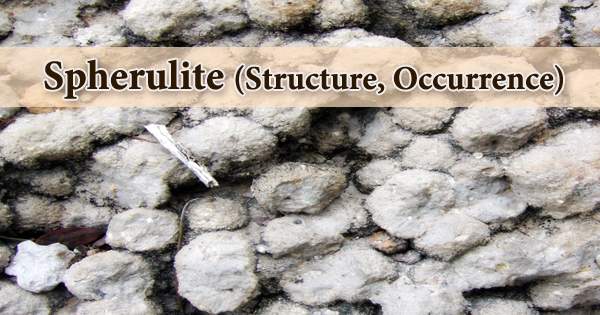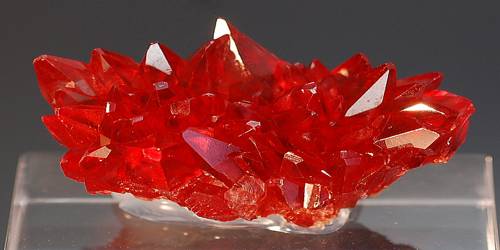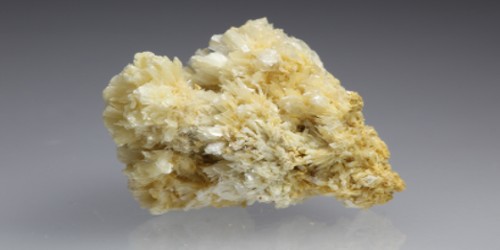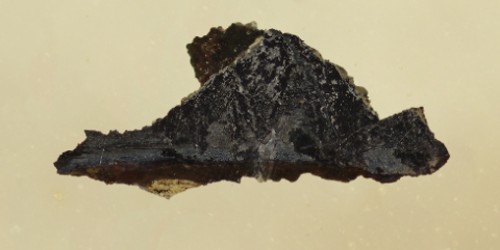Spherulites (/ˈsfɛrʊlaɪt/) are spherical bodies that can be found in glassy rocks, especially silica-rich rhyolites. They appear as globules about the size of millet seed or rice grain in specimens of obsidian, pitchstone, and rhyolite, with a duller luster than the surrounding glassy base of the rock, and when examined with a lens, they reveal a radiated fibrous structure. Spherulites are not one-of-a-kind entities; their textures differ depending on the growth condition and mechanism. Both attempts at textural classification, starting with the coarse/fine and compact/open distinctions suggested for lateral textures and optical observations, have so far proved to be insufficient due to the subtlety of the variation.
The intergrowth of quartz and orthoclase in spherulites also results in a radiating structure. These spherical bodies are thought to have evolved as a result of rapid mineral growth following nucleation, likely as a result of volatile accumulation. The spherulites have a circular form under the microscope and are made up of thin divergent fibers that are crystalline, as evidenced by polarized light. A black cross appears in the spherulite between crossed Nicols; its axes are generally perpendicular to one another and parallel to the crosshairs; the cross stays steady as the microscope stage is rotated; there are four light sectors between the black arms.
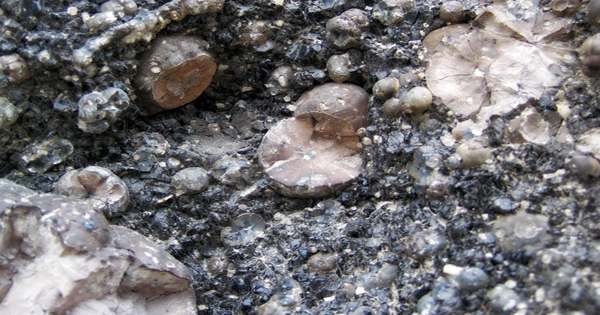
Although faecal spherulites are formed in the guts of many animals, herbivores such as cows, sheep, goats, llamas, and alpacas produce more of them. The spherulite is made up of radiate, doubly refracting fibers with a straight extinction; the extinguished fibers are represented by the arms of the black cross. Using visible light microscopy, the mixture is too finely grained to determine the minerals that make it up.
The reasons for the existence of spherulite are unknown, and many modern dung samples lack it. Animals grazing plants from soils with pH greater than 6 have a clear tendency to produce higher numbers of spherulites in samples that do contain them. The pH of the soil or sediment matrix plays a role in preservation, and values above pH 7.5 provide the best conditions.
Spherulites are useful dung markers in archaeological soil and sediment studies. Orbicules are spherulites that have concentric shells and can be found in granites and syenites. The shells have different mineralogies, and the bulk composition of orbicular granite and granodiorite varies from that of the host rock. They can make up the entire mass, but they’re more often surrounded by a glassy or felsitic foundation. The spherulites are often traceable when obsidians are devitrified, but they may be more or less fully recrystallized or silicified.
Orbicules are uncommon in gabbros; possible causes include glass devitrification around dispersed nuclei, contaminating simple rock inclusions, or a rhythmic crystallization around foreign fragments. A crystal (e.g., quartz or feldspar) or a cavity can be present in the center of a spherulite. Spherulites can have different colored zones and, although most are circular, they can also be polygonal or irregular in shape. In a glassy rock, perlites are spherical structures with onion-like partings. Shrinkage after solidification is responsible for their appearance, while concentric weathering may also produce a similar effect.
Spherulites in some New Zealand rhyolites send branching cervicorn processes (like stags horns) outwards through the rock’s surrounding glass. Broad, elliptical, or band-like spherulites are called axiolites. The structure of all of the spherulites mentioned so far is based on lamellar crystals radiating outwards from the middle. The early optical discovery of polymer spherulites as birefringent entities with radial symmetry may be described in this way. Perlites have high water concentrations, which may be linked to their sources, according to chemical analysis.
Spherulites as large as a few centimeters and, even more rarely, two to three meters in diameter have been discovered. Megaspherulites are spherulites that are larger than 20 centimeters in diameter. Varioles are pea-sized spheres that are inextricably linked to a fine-grained groundmass but differ in color, especially when weathered. Primary minerals are usually responsible for their formation. Megaspherulites with diameters ranging from 0.30 to 4.3 meters are contained within a dense layer of rhyolitic vitrophyre near Silver Cliff, Colorado. Megaspherulites as large as 0.91 meter in diameter have been discovered in rhyolite exposures on Steens Mountain, Oregon, and ones as large as 1.83 meter in diameter have been discovered in welded tuffs near Klondyke, Arizona.
However, in addition to the characteristic Maltese cross extinction pattern shown when such an object is viewed in plane-polarized light, spherulites with an additional pattern of concentric rings can be seen in some circumstances. Lithophysae are very large and cavernous spherulites found in obsidians at Lipari, Yellowstone Park, and other locations. The characteristic radiate fibrous structure is normally visible, but the fibers are often disrupted by cavities that resemble folded petals divided by arching interspaces, giving the spherulite a rosebud appearance.
Inside some glassy rocks, lithophysae are hollow, bubble-like, or rose-like shapes. They’re made up of concentric shells with hollow interspaces between them. Parallel membranes, which are continuations of laminations in the enclosing soil, penetrate many of them. Artificial glass crystallizes sometimes, producing spherulites as large as marbles. Since the glass has little in common with volcanic obsidians in terms of chemical composition, analyzing these spherulites reveals little about the mineral nature of spherulites in rocks.
Information Sources:
